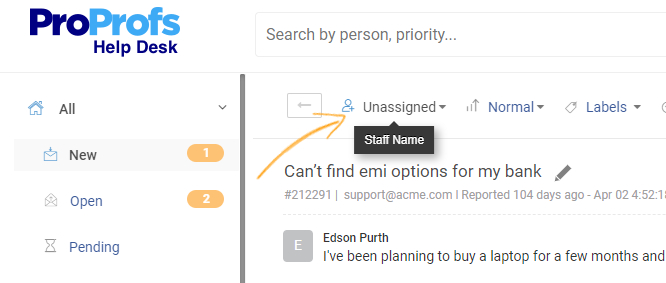Behind every delightful customer experience is a well-oiled help desk, quietly working its magic.
Imagine a world where every customer issue is resolved swiftly, every query answered with precision, and every support interaction leaves customers smiling.
Sounds like a dream? It’s not – it’s the result of implementing top-notch help desk management practices.
In this blog, we will understand the meaning of help desk management, discover the top help desk management best practices to streamline support operations and explore the role of AI help desk software in setting new standards for customer support excellence.
What Is Help Desk Management?
Help desk management refers to the processes and practices involved in organizing, overseeing, and optimizing a company’s customer support operations.
It encompasses the tools, strategies, and methodologies used to handle customer inquiries, troubleshoot problems, and provide solutions efficiently.
Effective help desk management ensures that support teams can deliver prompt, accurate, and high-quality assistance, leading to improved customer satisfaction and operational efficiency.
Key aspects of help desk management include ticketing systems, performance monitoring, team coordination, and the use of automation and AI to streamline support tasks.
11 Help Desk Management Best Practices
These best practices can help you create a more efficient, responsive, and customer-focused help desk, ultimately leading to higher customer satisfaction and loyalty.
1. Set Clear Goals & Expectations
Establishing clear goals and expectations is the cornerstone of effective help desk management.
Set specific, measurable, achievable, relevant, and time-bound (SMART) objectives to define success for your team.
These goals could include reducing response times, increasing customer satisfaction scores, or resolving a certain percentage of tickets within a specific timeframe. Clear goals help your team understand their targets and motivate them to work towards achieving them.
Equally important is setting clear expectations for both your support staff and your customers. Ensure your team knows the standards for response times, ticket handling procedures, and customer communication. Transparency in goals and expectations fosters accountability and improves overall service quality.
Looking to learn more? Take this quick course to watch SMART goals in action.
2. Automate Manual Tasks With AI-Powered Help Desk Software
Integrating AI-powered help desk software can revolutionize your support operations.
AI can handle repetitive tasks, such as sorting tickets and providing initial responses, freeing up your human agents to focus on more complex issues.
AI in help desk can give your agents a quick summary of a support ticket, highlighting the customer’s intent. It can also offer multiple response suggestions, that your team can use right away to save time and reduce effort.
Moreover, AI can provide valuable insights through data analysis, identifying common issues, and predicting future trends. This allows you to address potential problems and continuously improve your service proactively.
3. Provide Comprehensive Training
The help desk management process starts with well-trained staff.
Comprehensive training programs ensure that your support agents are equipped with the knowledge and skills they need to handle a variety of customer issues.
This includes training on your help desk software, product knowledge, and customer service best practices.
Ongoing training is just as important as initial onboarding. Regular workshops, webinars, and refresher courses keep your team updated on new features, industry trends, and evolving customer expectations.
4. Develop an Online Knowledge Base
A well-structured knowledge base is an invaluable resource for both your support team and your customers, especially when integrated with a cloud-based help desk system for easy access.
It serves as a centralized repository of information, including FAQs, troubleshooting guides, and how-to articles. This not only empowers your customers to find solutions independently but also equips your agents with quick access to information, reducing resolution times.
Regularly update your knowledge base to ensure it remains relevant and accurate. Encourage your support team to contribute by sharing insights and solutions to common problems they encounter. A comprehensive, up-to-date knowledge base enhances self-service options and boosts overall efficiency.
5. Implement Multi-Channel Support
In today’s digital age, customers expect to reach your support team through various channels, such as email, live chat, social media, and phone.
According to a Statista report, 54% of customers stated that they prefer phone calls to resolve customer service issues. Meanwhile, 38% prefer digital channels like live chat and social media.
Implementing multi-channel support ensures that your customers can contact you through their preferred method, enhancing their overall experience. Integrate these channels into a single platform to manage all interactions efficiently.
Unified multi-channel support also allows your team to maintain context across different channels. For example, if a customer starts a conversation via email and then switches to chat, your agents can seamlessly continue the conversation without missing a beat. This continuity is key to providing a consistent and satisfying customer experience.
6. Save Time With Canned Responses
Canned responses are pre-written replies to common queries that can save significant time for your support team.
By having a library of these responses, agents can quickly address frequently asked questions without having to type out the same answers repeatedly. This not only speeds up response times but also ensures consistency in communication.
However, it’s crucial to use canned responses thoughtfully.
Personalize them where possible to avoid sounding robotic and impersonal. Train your team to modify canned responses to fit the specific context of each customer interaction, striking a balance between efficiency and personalized service.
7. Prioritize & Categorize Tickets
Efficient ticket management is crucial for maintaining order and ensuring timely responses. Prioritize tickets based on urgency and impact.
For instance, tickets related to system failures or data security threats should be prioritized and addressed before general inquiries. Categorize tickets to streamline the workflow and ensure that they are directed to the right departments or agents.
Using help desk software that allows for tagging and categorization can significantly enhance this process. By organizing tickets into categories such as billing, technical support, and general inquiries, you can ensure that specialized agents handle relevant issues, improving the speed and quality of resolutions.
8. Track Help Desk Metrics & KPIs
FREE. All Features. FOREVER!
Try our Forever FREE account with all premium features!

 We'd love your feedback!
We'd love your feedback! Thanks for your feedback!
Thanks for your feedback!







